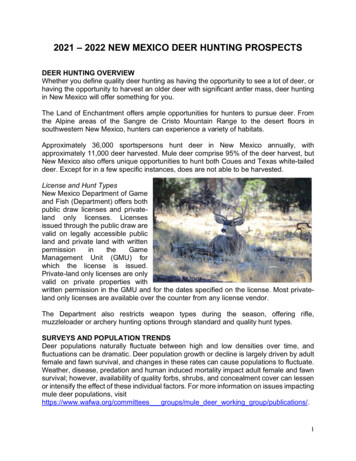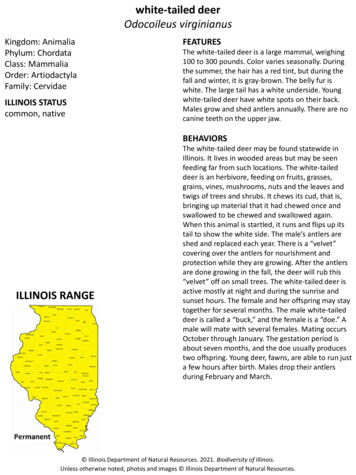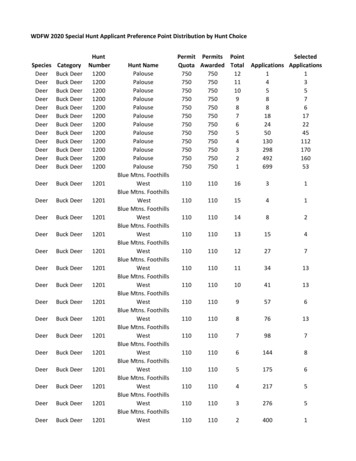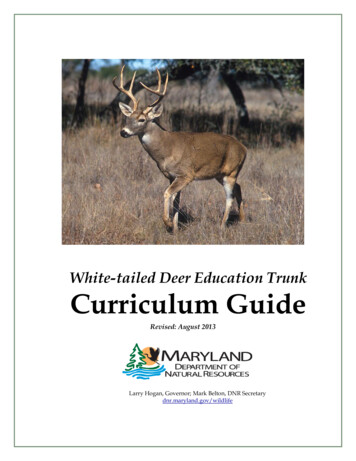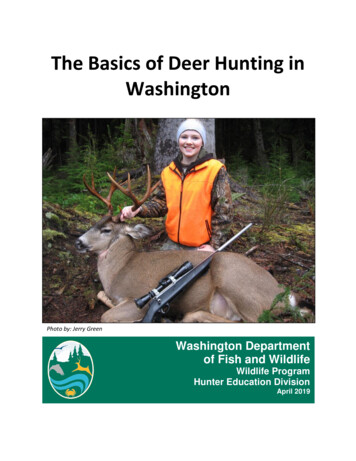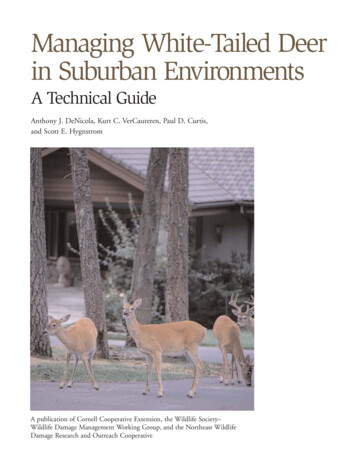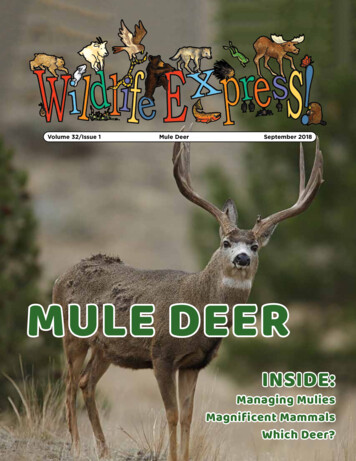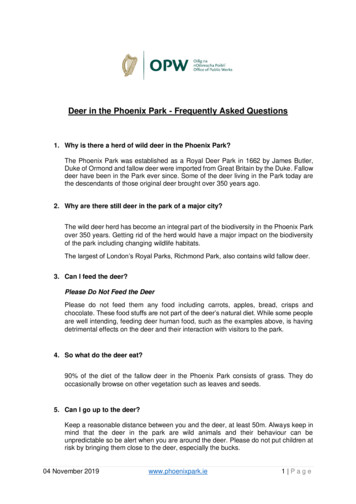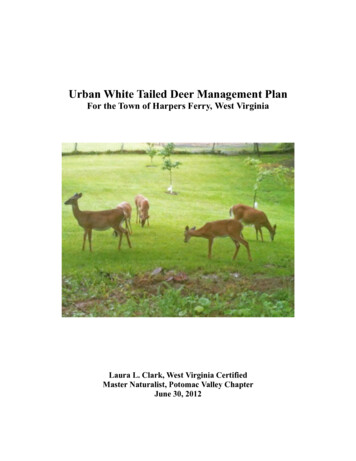
Transcription
Urban White Tailed Deer Management PlanFor the Town of Harpers Ferry, West VirginiaLaura L. Clark, West Virginia CertifiedMaster Naturalist, Potomac Valley ChapterJune 30, 2012
Table of ContentsPart IBackgroundA. Historical OverviewB. Current Population LevelsC. Local and State InvolvementPart IICurrent AssessmentA.B.C.D.E.Part III334Study AreaWildlife Camera SurveyCommunity SurveyDeer Plant Preference AssessmentImpact on Forested Areas5681012Management ProgramA. Program Goals and ObjectivesB. Regulated HuntC. Ordinance Revision131414Credits for Project Assistance and References15Attachments1. Study Plan2. Camera Survey results and specific site data3. Community Survey Form4. Urban Landscape Plant Survey5. Hunter Requirements and Rules of the Urban Archery Hunt6. Harpers Ferry Proposed Ordinance Revision7. Community Newsletter Articles – Public Education2
Part 1White Tailed Deer Management Plan: BackgroundA. Historical OverviewThe population of the White Tailed Deer, a native to the North American continent, has variedover time. Data on population levels before colonization is limited, but we know NativeAmericans relied on deer for food, shelter, clothing and tools. Prior to European settlement thepopulation estimates were 8 to 11 per square mile. (McCabe and McCabe 1984.) (1)With the arrival of the Eastern Europeans, the landscape of North America changed. Earlysettlers relied on deer to sustain themselves and had unregulated harvests. They eradicated theWhite Tailed Deer’s natural predators, including the Eastern Timber Wolf and Cougar in theeastern United States by the turn of the 20th century. In addition, deforestation took place duringthe 19th and early 20th century. The natural habitat of the White Tailed Deer changed and deerconservation strategies were established by 1930, including the reintroduction of deer in the MidAtlantic region. (2)The landscape of North America continues to evolve. Since 1980, the White Tailed Deerpopulation has rebounded and conflicts between humans and deer have risen. The habitatcurrently found in Harpers Ferry, West Virginia, is a mix of forest, open field, residential housingand National Historical Park. The forest, park and open fields, as well as agricultural areas,provide an ideal habitat for deer. The deer are continuing to adapt to urban residential settings.Not only are there no predators in their natural habitat, they have learned that urban areas aresafe from hunting and have more attractive food sources.B. Current Population LevelsThe town of Harpers Ferry is surrounding by the Harpers Ferry National Historical Park whichprovides many benefits including protection and preservation of the area surrounding the town.But, with this resource comes an abundance of White Tailed Deer. Population estimatesprovided by the National Park Service for this region vary considerably. Acceptable deerdensities, according to the Park Service range from 15 to 35 per square mile.Harpers Ferry National Historical Park Service estimates for 2011 (based on pellet counts,thermal imaging and other techniques) for Harpers Ferry area are as follows:Maryland Heights 90Loudoun Heights 57Bolivar/Elk Run 80Short Hill 253
Estimates of deer per square mile from 2011 from other National Parks in the region are asfollows:Valley Forge National Historical Park (PA)Antietam National Battlefield Park (MD)Manassas National Battlefield Park (VA)Monocacy National Battlefield Park (MD)241130172235A more exact deer population within the town limits of Harpers Ferry would be very difficult toestablish, given the movement of the deer in and around the town and the seasonality of the deerbehavior. A wildlife camera survey was done in April of 2012, to document the movement of thedeer within town limits. Thermal imaging to provide a more accurate count was originallyplanned, but not done. However, documentation from the Camera Survey, the Harpers FerryNational Park Service information, and the Resident Survey results were more than adequate foridentifying the problems in this management plan.C. Local and State InvolvementA study plan (see Attachment A) for doing a White Tailed Deer Management Plan was submittedto Harpers Ferry Town Council at the March 2012 meeting. The author gave a brief presentationand the Council approved going forward with the Plan (and authorized an thermal imagingsurvey of the deer population.)After receiving Council approval to proceed, the author arranged a meeting with local bowhunters who had volunteered to assist in the Wildlife Camera Survey. One of the hunters wasespecially helpful in that he'd been involved in similar deer management programs in problemareas of northern Virginia.West Virginia Department of National Resources has guidelines for Deer Management thatincludes both harvest and habitat management. The Department has found that deer herds willincrease 30 to 40 percent each year when protected and under good habitat conditions. In theirexperience, the only economically practical method of deer harvest management is throughregulated hunting.The Department has specific guidelines for Urban Deer Management, including an extendedseason, designating the number of deer harvested per hunter, and an archery-only program.In preparing this management plan, the author also met several times with staff of the HarpersFerry National Historical Park. They share the concern that deer over-population is causingsignificant damage to the natural resource balance within the Park. (It should be emphasized thathunting is forbidden within the national parks. The Park is managing their resources as requiredby federal mandate. Extensive environmental review is required before the Park would be able toproceed with a similar program.)4
PART IICurrent AssessmentPart 2 documents the problems associated with the current deer population levels within the townof Harpers Ferry.A. Study AreaThe study area includes the town limits of Harpers Ferry, as well as the unincorporated area ofBolivar Heights. Harpers Ferry is a small community of about 285 residents on a peninsulabordered by the Potomac River to the north and the Shenandoah River to the south. It is 0.6square miles in land area. The Harpers Ferry National Historical Park takes up part of theincorporated area of Harpers Ferry.The adjoining town of Bolivar, West Virginia, did not elect to participate in the study or currentassessment program. However, the town is currently seeking property owners who wouldconsider participating in an Urban Archery Hunt.Study Area MapRed line: Incorporated areas of Bolivar to left, Harpers Ferry to right.Light green area: Harpers Ferry National Historical Park land.#1-#8: Wildlife Camera Survey positions.5
B. Wildlife Camera SurveyProcedure DescriptionThe study area map shows the 8 camera positions on the Potomac River or north side of townwhere six volunteers set out wildlife cameras April 6-8, 2012. Human interaction with deer iswidespread throughout the community, but the north side of town has more notable damagereports.These camera positions were selected after consulting with local hunters for purposes of thisstudy and to assess potential hunt sites. The author visited each site, took GPS coordinates, andnoted adjacent property and proximity to housing and public buildings. Site selection wasexcellent an coverage of the peninsula was good.No sites were located on the south side of town or around Boundary Street or Union Street. Thehousing density in this area is tight and the hunters did not consider this an appropriate potentialhunt site. The community survey shows that Union Street has vehicle “near misses” turning offthe main highway, and Washington Street has deer trails and movement from one side of town tothe other.Equipment was donated by the local hunters and included both video style and movementsensitive style cameras. Corn bait from a local grower (to avoid inadvertent contamination) wasused to bait the camera positions on the afternoon of April 6. The cameras were in use until theafternoon of June 8. Cameras were removed on June 8 and 9.6
Ideal study conditions would have been during the fall months, with antlered deer, and when thedeer are most active. But, the program got underway during the spring months, and to facilitate aprogram being implemented in 2012, the camera survey was done in April.ResultsVolunteers and the author reviewed hundreds of photos. A spreadsheet, set up with the time anddate and camera position for each photo, showed simultaneous hits, and deer movement fromone position to another. Within the first hours of the cameras being placed, six of the sevencamera positions had simultaneous hits with a total count 26 deer at the six cameras. Fivecamera positions typically had six deer photographed at one time during the 3-day period.Position 6, off Putnam Street, showed nine deer bedded down the afternoon of June 7.Of interest were deer that were undersized or in poor condition (pictured below). With many ofthe pictures at night or at a distance it was hard to determine the number of bucks. Two bucks inantlerless phase could be identified.Also of interest and some concern, were people walking through the photographed areas. Thedeer, comfortably bedded down for the afternoon, suddenly ran off, a person appeared and left.Within 10 minutes, the deer were back and bedded down. The author later learned that a dog hadgone missing in this area and several residents were involved in the hunt for the missing dog.This likely accounts for the high foot traffic.Other wildlife photographed included raccoon, fox, squirrels, turkey vultures and a possible bearcub.Details of the camera survey by camera position are found in Attachment B. This attachmentalso includes volunteers and property owner information. Results for Bolivar Heights sites,positions 1 and 2, were combined because of their close proximity.7
In summary, while not used to obtain an accurate deer count, the Wildlife Camera Surveyconducted by the volunteers, demonstrates that deer exist in significant numbers and arecomfortable bedding down within the town limits. Given the high cost of thermal imaging, theauthor believes it is not warranted since the wildlife cameras showed deer population numberswell in excess of a healthy deer to land area ratio. The high deer numbers were also evident inthe data received in the Community Survey.C. Community SurveyDescriptionA community survey form was distributed to the members of the community in April and May of2012. The survey form was published in the Harpers Ferry town newsletter distributed online,left on the desk at the town hall reception window and on the post office table. A total of 33voluntary responses were obtained. In 2010, the Town of Bolivar had 23 residents report deerproblems on their complaint form. Using Water Department household service accounts (812 forBolivar and Harpers Ferry and immediately adjoining unincorporated area) as a base, thecombined total (56) answering the surveys indicates a rate of response as high as 7%.A copy of the Survey form is found in Attachment C. This survey is not a representative samplebecause it was a voluntary submission, and because of the low sample size, but nevertheless hasgood information provided by community members.8
Results: Incidence of Lyme DiseaseEleven households reported 13 cases of Lyme disease within the last two years on the 2012Community Survey. In other words, 33% of the households participating in the survey have beentreated for Lyme disease.The Center for Disease Control publishes data on confirmed cases that are reported to them. For2010, there were 7.3 confirmed cases per 100,000 population nationally. The local healthdepartment does not have data on Lyme disease.In 2011, the Center for Disease Control came to Harpers Ferry National Historical Park andcollected and tested 13 ticks in six different parts of the Park. None of the ticks tested positivefor Lyme. It is not possible to determine where our residents are contracting Lyme. But, theincidence rate is high in our community, and we do have a public health issue in Harpers Ferry.The Center for Disease Control's website shows the White Tailed Deer as a host of the tick thatcarries Lyme disease and states that the risk of greatest human infection is in late spring andsummer, prime outdoor times for humans in this area.Results – Deer in YardsAll 33 of the Survey respondents reported having deer in their yards. A summary of where thedeer are concentrated is as follows:Average NumberNumber ofLocationof Deer in YardHouseholds ReportingChurch Street5.02Washington Street6.08East Ridge4.54Union Street13.03West Ridge11.02All other7.76This information was consistent with the Camera Survey data obtained in April 2012. We had anaverage of 6 deer in the cameras, but there may have been more due to the limited range of thephotographs. The table also shows the risk of having a collision with a deer on Union Street.Results – Automobile EncountersThe Survey asked about encounters with deer while in an automobile. Drivers going the postedspeed limit of 25 (or 15) miles per hour will likely have time to stop in most cases. Of therespondents, six reported having no incidents, while 26 did. One resident reported a vehicle-deercollision on State Highway 340 (which passes Harpers Ferry) resulting in 4,000 in damages,and a Harpers Ferry police cruiser was in a collision with a deer in 2010.9
State Farm Insurance reports on deer-vehicle collisions annually. As headlined on their website(www.statefarm.com) in October, 2011, "U.S. Deer-Vehicle Collisions Fall 7 Percent; MishapsMost Likely in November And in West Virginia." West Virginia, according to their report, leadsthe nation for the fifth year in a row, for where an individual driver is most likely to run into adeer.Lastly, Survey comments on automobile encounters in this area included the following:“Deer stand in road and face cars down.”“Ran in front of me and glanced off bumper.”“Dodged them running across Washington Street.”“Two near misses on Washington Street.”“We observe many close calls on Union Street.”Results – General CommentsThe Survey form included blank lines at the bottom for open comments. The possibility of having ahunt to reduce the herd was not mentioned, but 7 of 33 respondents said specifically that theywere in favor of such a program, while one was not. Generally, the following commentssummarize the current culture regarding deer in Harpers Ferry:“The deer are a part of the charm of our community.”“As much as I like to see the deer, there are too many for the area.”There are a few individuals who spoke to the author against an urban hunt program, and there arealso residents who are angry and frustrated over the loss of expensive and carefully tendedgardens to hungry deer. One resident, after learning of another resident being knocked out by aspooked deer in his yard, said she no longer walked after dark on West Ridge Street for fear ofbeing hit by a running deer.D. Deer Plant Preference AssessmentThe community reported 62 varieties of urban plants being browsed by deer. Rutgers Universityand the New Jersey Agricultural Experimental Station have developed a Deer BrowsingDesirability Rating Chart to indicate plant preference by browsing deer. Plants range from A,least desirable and rarely damaged by deer browsing, to D, most desirable and most oftendamaged by deer browsing.10
Deer browse line on yews at 900 Fillmore StreetPlants Most Reported Damaged by Deer in the SurveyPlant TypeHostasTulipsRosesHydrangeasImpatiensAzaleasDay LillyRutgersRatingDDCCCDDResponses14887655In addition to the plants with desirability rated by Rutgers, seven survey respondents reporteddamage on garden vegetable plants which are not rated. (See Attachment D for more details onplant species and browsing desirability rating.) The following plants with the low desirablerating of B were reported by two or more households as being browed by deer: 3 householdsreported Black-Eyed Susan and Forsythia; 2 households reported Columbine, Crocus and WitchHazel.The deer are browsing the most desirable plants, but also are starting to take B-rated or SeldomBrowsed plants. While it is possible some reported damage may have been caused by otherspecies (groundhogs and rabbits are common in town), many residents witnessed the deeractually browsing the plants reported.11
Increasingly, fencing is going up around gardens in the community. This may keep the deer out,but the fencing can also make for a less appealing urban landscape, as well as being costly toinstall.Newly Fenced Garden on Washington StreetE. Impact on Forested AreasHarpers Ferry has within its town limits natural forested areas including private property, paperstreets and flood zones. Heavy browsing in these areas is adversely impacting the health of theforests as young seedings are browsed and non native species move in. The picture below showsthe browse line found throughout the area and a forest floor covered with invasive garlic mustardwith no forest regeneration occurring.Forested Area near Cedar Hill Cemetery12
PART IIIManagement ProgramA. Program Goals and ObjectivesThe Current Assessment documented the problems associated with the high deer populationlevels within the town limits of Harpers Ferry. Based on this Current Assessment and WestVirginia Department of Natural Resources recommendations, this report concludes that anantlerless only, White Tailed Deer Urban Archery Program, should be implemented in order tolimit the number of White Tailed Deer in Harpers Ferry town limits.Specifically, the program goal and objectives are as follows:GOAL: To ensure measures are taken to optimize both public health and the health of the WhiteTailed Deer in our community.OBJECTIVES:1. Decrease the number of resident complaints and encounters.2. Decrease the Lyme disease rate.3. Discourage deer herding within town limits.4. Minimize vehicle encounters.5. Continually assess the health of the deer in town by monitoring the appearance, thereproduction rate, and work with West Virginia Department Department of Natural Resourceson potential or suspected onset of disease.This report is not recommending an optimum deer population for the town of Harpers Ferry. Thetown is surrounded by Harpers Ferry National Historical Park property where efforts to deal withthe overpopulation is in progress, but no action can be taken at this time. Dale Nisbet, ResourceManagement Specialist at the Park has seen property owners adjacent to the Park making adifference. When the local hunters harvested deer adjacent to Maryland Heights, the estimatedpopulation levels dropped from 124 to 68 per square mile.13
B. Regulated HuntThe Hunter Requirements and Rules (see Attachment E) of the hunt were developed by our localhunters based on the rules used by Morgantown, West Virginia Urban Hunt Program, and theRules and Regulations used by Suburban Whitetailed Management of Northern Virginia, a nonprofit group of archery hunters assisting landowners in Northern Virginia with deer managementsince 1997. The goal of the requirements and rules are to insure the utmost care is taken for thesafety of the community, and to insure that only qualified hunters are participating.The hunter requirements and rules of the hunt were also reviewed by West Virginia Departmentof Natural Resources which found the proposed requirements and rules to be strict and likely toreduce the number of hunters willing to participate in the hunt. The hunt will be limited toresidents of Harpers Ferry and property owner designees during the first season. With TownCouncil approval of the program, the Urban Archery Hunt is expected to begin in the fall of2012. The requirements and rules will be re-evaluated after the first season to see if changes areneeded.These rules were also reviewed and approved by both the Harpers Ferry Police Chief and theChief Ranger of Harpers Ferry National Historical Park. Since many of the hunting zones are inclose proximity to Harpers Ferry National Historical Park, Park assistance may be necessary fortrack and retrieval of deer shot within the established hunting zones that fall on Park property.Hunting is NOT permitted in Harpers Ferry National Historical Park.C. Harpers Ferry Ordinance RevisionAs currently written, Section 505.05 of the Harpers Ferry Town Code prohibits hunting within thelimits of Harpers Ferry. An ordinance revision has been drafted to allow for an Urban DeerManagement Program. (See Attachment F.)Public comment is currently being solicited and a public meeting is scheduled for July 2 toeducate the community on the program and receive comments. First reading of the proposedordinance is scheduled for July 9.14
Credits for Project AssistanceRich Rogers, West Virginia DNR, District Wildlife BiologistJosh Vance, West Virginia DNR, Wildlife ManagerDale Nisbet, Resource Manager, Harpers Ferry National Historical ParkJohn Brown, Harpers Ferry Police ChiefJeff Woods, Chief Ranger, Harpers Ferry National Historical ParkChristy Huddle, ResidentManagement Program Objective Development and author Regulations and Rules ofHunt, and the Draft Ordinance, proofing and submittal Community Newsletter ArticlesRoger Harris, Wildlife Camera Survey, Development of Requirements and Rules of the HuntWildlife Camera Survey VolunteersRay DillowJames WoodsBart WheatlyDick PotteigerWayne BishopWildlife Camera Equipment DonorsMark GauntnerRodger HarrisWildlife Camera Survey Photo Review and Data SummaryJoan GoodyDavid ArcherPlant Survey Summary, Technical Assistance, Proof ReadingPamela SheetsReferences(1) Valley Forge National Historical Park White Tailed Deer Management Plan Dec 2008(2) State of Maryland White Tailed Deer Management Plan 2009 – 201815
The natural habitat of the White Tailed Deer changed and deer conservation strategies were established by 1930, including the reintroduction of deer in the Mid Atlantic region. (2) The landscape of North America continues to evolve. Since 1980, the White Tailed Deer population has rebounded and conflicts between humans and deer have risen. The .
